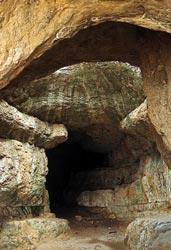Szelim cave
This article needs additional citations for verification. |
This article has been translated from the article Szelim-barlang in the Hungarian Wikipedia, and requires proofreading. |

The Szelim cave located in Hungary, on the Kő-hegy (Stone mountain) above Tatabánya (Hungarian: Szelim-barlang an other name : Szelim-lyuk (Szelim hole),Bánhidai nagy barlang (Bánhidian big cave), Eperjes-barlang, Szemi-luki, Szemi-lyuka, Szelimluk barlang, Bánhidai-zsomboly, Szent Vit-barlang). This cave is 45 m long and 14 m tall, which a water flow hollowed out of the limestone rock. The cave the upper triad in the thick benches of limestone the rock North-East-South-West direction his fault line done, but the residue of a source cave, which turned into dry one with the bulge of the mass of the mountain, took shape conforming to the rock tilt once. Four of his entrances a spacious one, initially 25-27 m, drives into a hall with a longitude of 45 m with a width of 10-12 m, the altitude of which attains the 12-14 meters here and there, farther in. The present nadir of the cave the ceiling former from him breaking in and it it follower being washable standing ruin forms it from loess clay coming from and rubble. The cave continues presumably behind the ruin. The cave a prehistoric man proved to be a toft.[1]
The legends of the cave
The basis of exciting historical legend which is in connection with the cave, is that the rain water flowed through the cave's flue washed away human bones from the soil during centuries.
- According to the oral tradition the population of 7 neighboring villages escaped to the depth of the earth during the Turkish wars from Szelim sultan's troops who devastated Transdanubia. Unfortunately, Turkish found the people who hid in the cave and they killed them by the smoke of the bonfire they pur to the opening of the cave.[2]
- The population of the villages surrounding the refuge being looked for in the cave on the time of the Tartar attacks. When a little boy got thirsty then aloud started crying, his mother took it away the close to a source. The Tartars, who had the woman compelled to reveal the cache of the others, captured them however there.
The archeologist of the Hungarian National Museum did an excavation on this area in the 1930's, later stating that the legendary disasters could have happened in a much earlier period, but the sliding memory of the community linked it to an event that happened centuries later.
References
| This article contains a translation of Szelim-barlang from hu.wikipedia. (362259505 et seq.) |




